

Compact Muon Solenoid
LHC, CERN
| CMS-PAS-EXO-17-021 | ||
| Search for pair-produced resonances decaying to quark pairs in proton-proton collisions at √s= 13 TeV | ||
| CMS Collaboration | ||
| June 2018 | ||
| Abstract: A search for the pair production of resonances decaying to two quarks is reported. The search is conducted separately for lighter resonances between 80 and 400 GeV in mass, when the resulting diquark decay products are collimated and reconstructed as a single jet producing a dijet final state, and for heavier resonances above 400 GeV in mass, when the decay products generate pairs of hadronic jets producing a four-jet final state. In addition, a b-tagged selection is applied to target resonances with a bottom quark in the final state. The analysis uses data collected with the CMS detector at the LHC, corresponding to an integrated luminosity of 35.9 fb−1 from proton-proton collisions at a center-of-mass energy of 13 TeV. The mass spectra are analyzed for the presence of new resonant particles, and are found to be consistent with standard model expectations. The results are interpreted in the framework of R-parity-violating supersymmentry assuming the pair production of scalar top quarks decaying via the λ′′312 or the λ′′323 hadronic couplings, and upper limits are placed on the pair production cross section of top squarks as a function of the top squark mass for the two hadronic coupling scenarios. | ||
|
Links:
CDS record (PDF) ;
CADI line (restricted) ;
These preliminary results are superseded in this paper, PRD 98 (2018) 112014. The superseded preliminary plots can be found here. |
||
| Figures | |
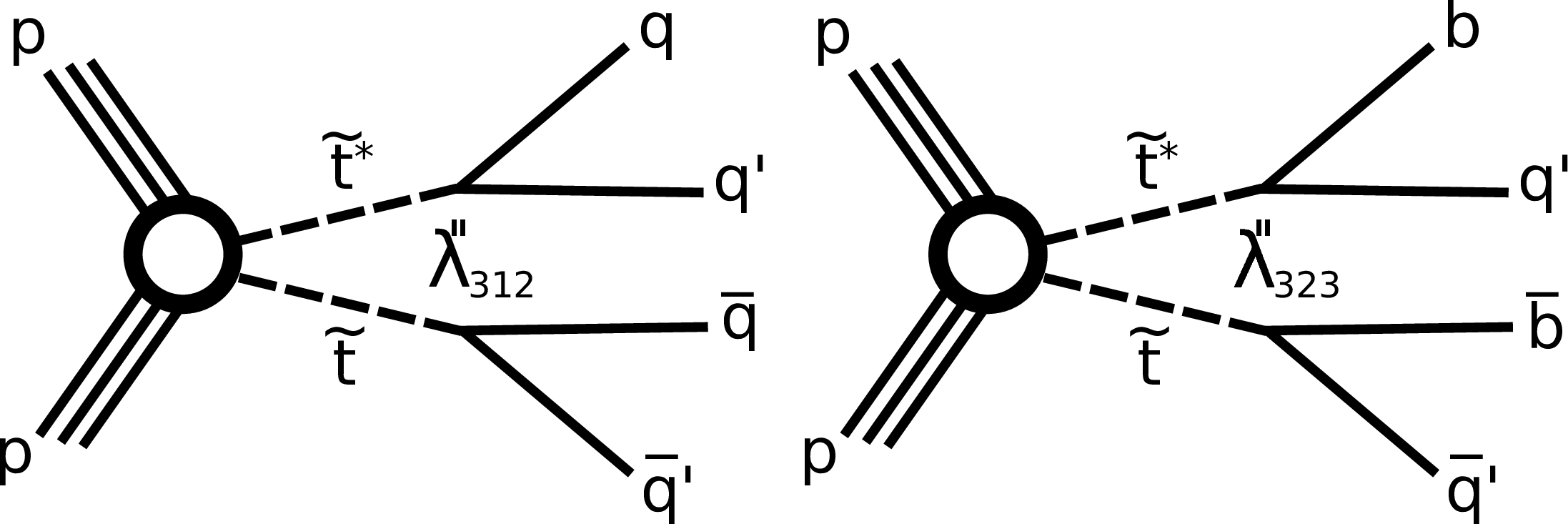
png pdf |
Figure 1:
Diagrams for the benchmark models used in this analysis: pair production of top squarks decaying into qq′ via the RPV λ′′312 coupling (left), and bq′ via the RPV coupling λ′′323 (right). |
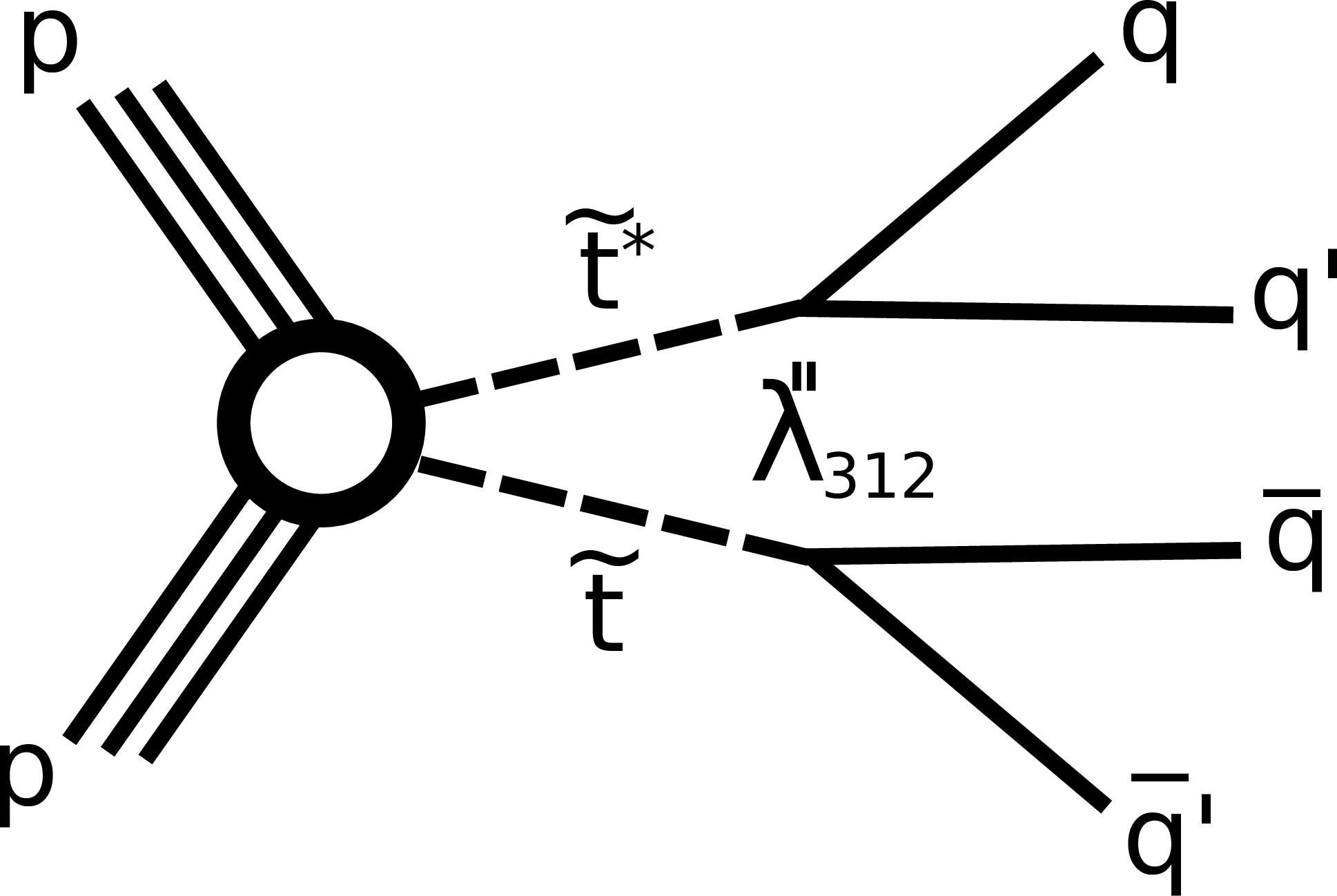
png pdf |
Figure 1-a:
Diagrams for the benchmark models used in this analysis: pair production of top squarks decaying into qq′ via the RPV λ′′312 coupling (left), and bq′ via the RPV coupling λ′′323 (right). |
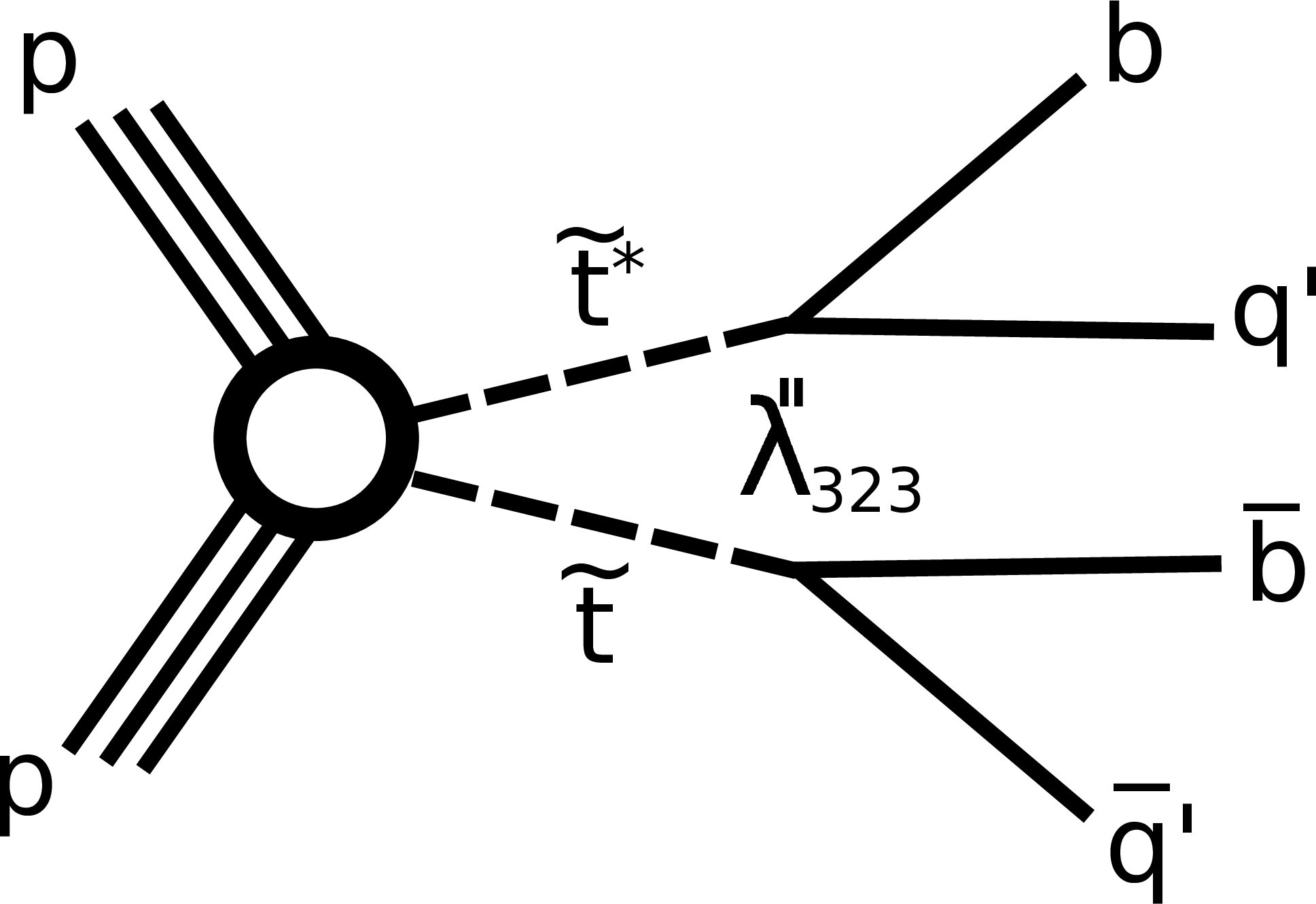
png pdf |
Figure 1-b:
Diagrams for the benchmark models used in this analysis: pair production of top squarks decaying into qq′ via the RPV λ′′312 coupling (left), and bq′ via the RPV coupling λ′′323 (right). |

png pdf |
Figure 2:
Boosted search: Kinematic distributions normalized to unity showing the comparison between data (black dots), backgrounds (solid colored lines), and a few selected ˜t→qq′ signal simulated samples (dashed colored lines). All selection criteria are applied apart from that on the variable being presented. In the case of the τ21 and τ32 variables both τ21 and τ32 requirements are removed. The black dashed lines represent where the selection is applied. Top left: masym. Top right: Δη. Middle left: leading jet τ21. Middle right: subleading jet τ21. Bottom left: leading jet τ32. Bottom right: subleading jet τ32. |
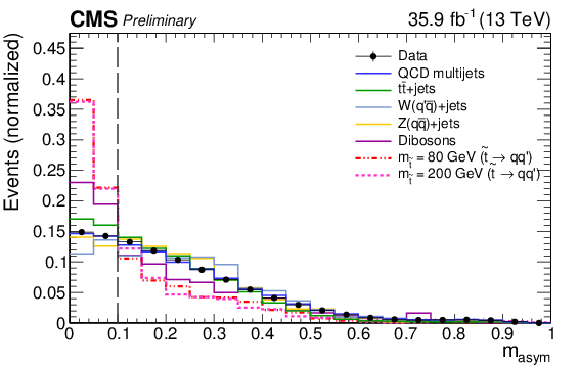
png pdf |
Figure 2-a:
Boosted search: Kinematic distributions normalized to unity showing the comparison between data (black dots), backgrounds (solid colored lines), and a few selected ˜t→qq′ signal simulated samples (dashed colored lines). All selection criteria are applied apart from that on the variable being presented. In the case of the τ21 and τ32 variables both τ21 and τ32 requirements are removed. The black dashed lines represent where the selection is applied. Top left: masym. Top right: Δη. Middle left: leading jet τ21. Middle right: subleading jet τ21. Bottom left: leading jet τ32. Bottom right: subleading jet τ32. |
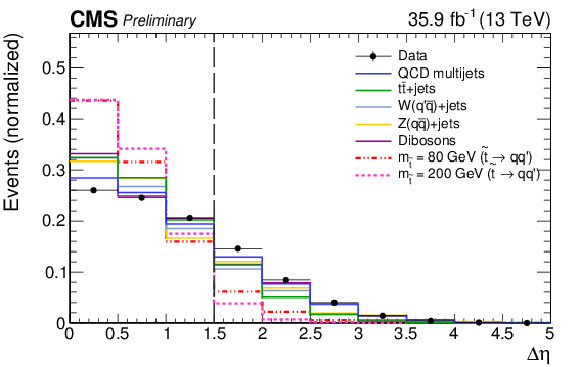
png pdf |
Figure 2-b:
Boosted search: Kinematic distributions normalized to unity showing the comparison between data (black dots), backgrounds (solid colored lines), and a few selected ˜t→qq′ signal simulated samples (dashed colored lines). All selection criteria are applied apart from that on the variable being presented. In the case of the τ21 and τ32 variables both τ21 and τ32 requirements are removed. The black dashed lines represent where the selection is applied. Top left: masym. Top right: Δη. Middle left: leading jet τ21. Middle right: subleading jet τ21. Bottom left: leading jet τ32. Bottom right: subleading jet τ32. |
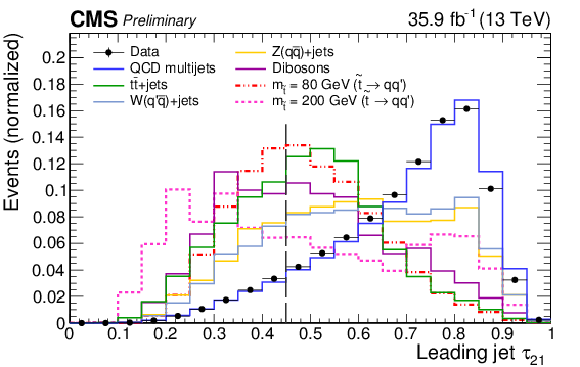
png pdf |
Figure 2-c:
Boosted search: Kinematic distributions normalized to unity showing the comparison between data (black dots), backgrounds (solid colored lines), and a few selected ˜t→qq′ signal simulated samples (dashed colored lines). All selection criteria are applied apart from that on the variable being presented. In the case of the τ21 and τ32 variables both τ21 and τ32 requirements are removed. The black dashed lines represent where the selection is applied. Top left: masym. Top right: Δη. Middle left: leading jet τ21. Middle right: subleading jet τ21. Bottom left: leading jet τ32. Bottom right: subleading jet τ32. |
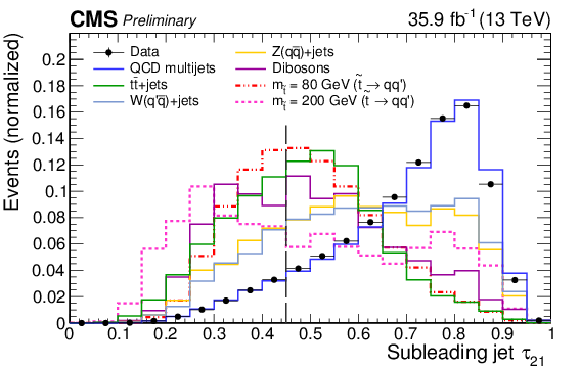
png pdf |
Figure 2-d:
Boosted search: Kinematic distributions normalized to unity showing the comparison between data (black dots), backgrounds (solid colored lines), and a few selected ˜t→qq′ signal simulated samples (dashed colored lines). All selection criteria are applied apart from that on the variable being presented. In the case of the τ21 and τ32 variables both τ21 and τ32 requirements are removed. The black dashed lines represent where the selection is applied. Top left: masym. Top right: Δη. Middle left: leading jet τ21. Middle right: subleading jet τ21. Bottom left: leading jet τ32. Bottom right: subleading jet τ32. |

png pdf |
Figure 2-e:
Boosted search: Kinematic distributions normalized to unity showing the comparison between data (black dots), backgrounds (solid colored lines), and a few selected ˜t→qq′ signal simulated samples (dashed colored lines). All selection criteria are applied apart from that on the variable being presented. In the case of the τ21 and τ32 variables both τ21 and τ32 requirements are removed. The black dashed lines represent where the selection is applied. Top left: masym. Top right: Δη. Middle left: leading jet τ21. Middle right: subleading jet τ21. Bottom left: leading jet τ32. Bottom right: subleading jet τ32. |

png pdf |
Figure 2-f:
Boosted search: Kinematic distributions normalized to unity showing the comparison between data (black dots), backgrounds (solid colored lines), and a few selected ˜t→qq′ signal simulated samples (dashed colored lines). All selection criteria are applied apart from that on the variable being presented. In the case of the τ21 and τ32 variables both τ21 and τ32 requirements are removed. The black dashed lines represent where the selection is applied. Top left: masym. Top right: Δη. Middle left: leading jet τ21. Middle right: subleading jet τ21. Bottom left: leading jet τ32. Bottom right: subleading jet τ32. |

png pdf |
Figure 3:
Boosted search: Left: Signal mass distributions for various simulated ˜t→qq′ masses probed in this analysis after applying the inclusive selection. Right: Signal efficiency as a function of m˜t for the inclusive and b-tagged selections. |
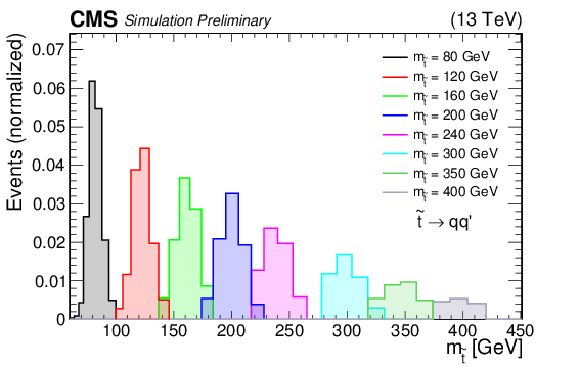
png pdf |
Figure 3-a:
Boosted search: Left: Signal mass distributions for various simulated ˜t→qq′ masses probed in this analysis after applying the inclusive selection. Right: Signal efficiency as a function of m˜t for the inclusive and b-tagged selections. |
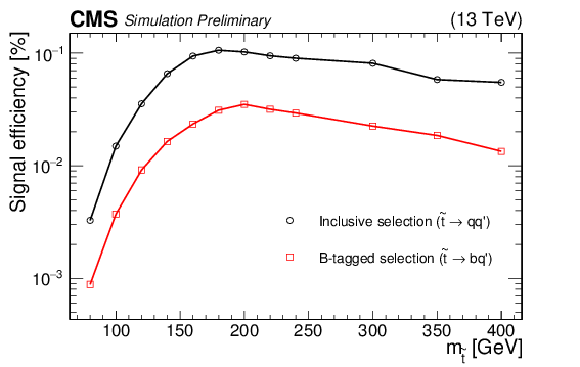
png pdf |
Figure 3-b:
Boosted search: Left: Signal mass distributions for various simulated ˜t→qq′ masses probed in this analysis after applying the inclusive selection. Right: Signal efficiency as a function of m˜t for the inclusive and b-tagged selections. |
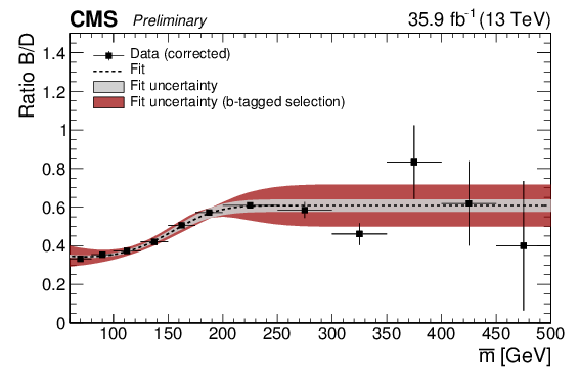
png pdf |
Figure 4:
Boosted search: Transfer factor B/D as a function of ¯M for data (black points) corrected for the resonant background component. Fit to the data (black dotted line) with the sigmoid function described in Eq. (2) is also presented. Gray and red bands represent the uncertainties of the fit for the inclusive and b-tagged selection, respectively, and are used as systematic uncertainties. |
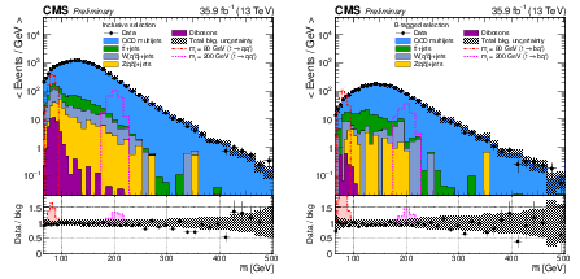
png pdf |
Figure 5:
Boosted search: ¯M distribution shown for data (black points) and the total background prediction. Left: inclusive selection. Right: b-tagged selection. The different background components are illustrated with different colors while the grey hashed band displays the total background uncertainty. On the bottom we show the ratio between data and the background prediction. The shaded colored regions on the bottom illustrate the effect when including a top squark signal for two different top squark masses. |
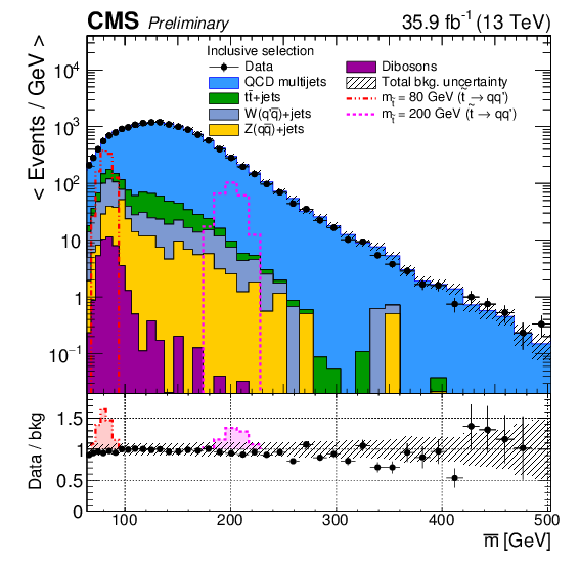
png pdf |
Figure 5-a:
Boosted search: ¯M distribution shown for data (black points) and the total background prediction. Left: inclusive selection. Right: b-tagged selection. The different background components are illustrated with different colors while the grey hashed band displays the total background uncertainty. On the bottom we show the ratio between data and the background prediction. The shaded colored regions on the bottom illustrate the effect when including a top squark signal for two different top squark masses. |
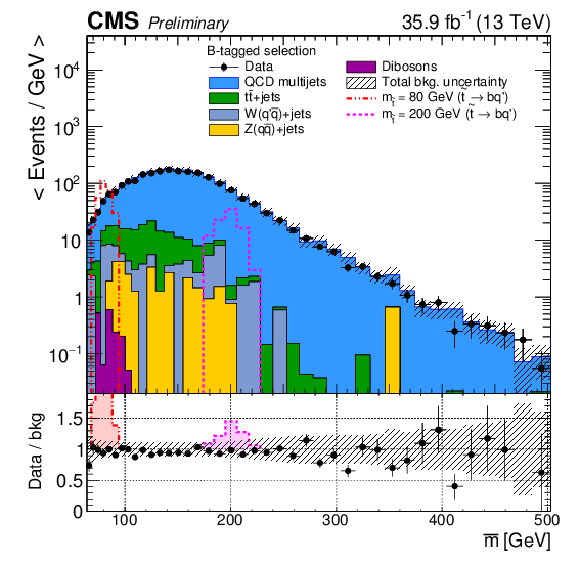
png pdf |
Figure 5-b:
Boosted search: ¯M distribution shown for data (black points) and the total background prediction. Left: inclusive selection. Right: b-tagged selection. The different background components are illustrated with different colors while the grey hashed band displays the total background uncertainty. On the bottom we show the ratio between data and the background prediction. The shaded colored regions on the bottom illustrate the effect when including a top squark signal for two different top squark masses. |

png pdf |
Figure 6:
Resolved search: The Masym distribution normalized to unity showing the comparison between data (black dots), background (solid blue line), and a selected signal ˜t→qq′ with a m˜t= 500 GeV (dashed red line). All selection criteria are applied apart from that on the variable being presented, and the region to the left of the black dashed line indicates the optimized region of selected Masym values. |

png pdf |
Figure 7:
Resolved search: The ηjj1 value of the higher pT dijet system in the selected pair as a function of the ηjj2 value of the lower pT dijet system. The distribution is shown for simulated QCD multijet events (left) and a selected signal ˜t→qq′ with a m˜t= 500 GeV (right). All selection criteria are applied apart from that on the variable being presented, and the region between the two red dashed lines indicates the optimized region of selected Δηdijet values. |
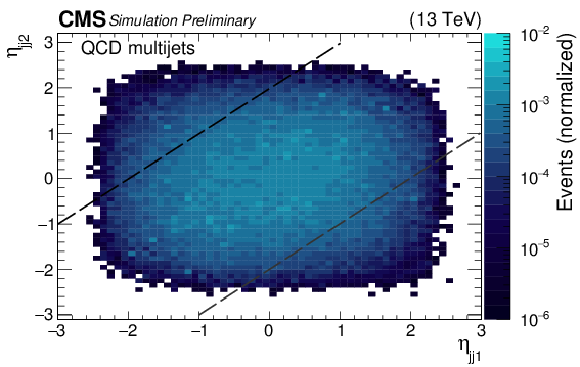
png pdf |
Figure 7-a:
Resolved search: The ηjj1 value of the higher pT dijet system in the selected pair as a function of the ηjj2 value of the lower pT dijet system. The distribution is shown for simulated QCD multijet events (left) and a selected signal ˜t→qq′ with a m˜t= 500 GeV (right). All selection criteria are applied apart from that on the variable being presented, and the region between the two red dashed lines indicates the optimized region of selected Δηdijet values. |
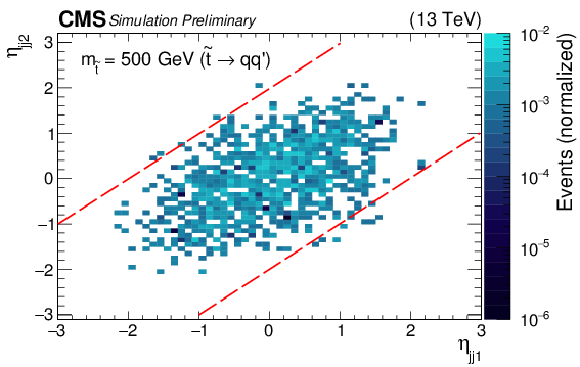
png pdf |
Figure 7-b:
Resolved search: The ηjj1 value of the higher pT dijet system in the selected pair as a function of the ηjj2 value of the lower pT dijet system. The distribution is shown for simulated QCD multijet events (left) and a selected signal ˜t→qq′ with a m˜t= 500 GeV (right). All selection criteria are applied apart from that on the variable being presented, and the region between the two red dashed lines indicates the optimized region of selected Δηdijet values. |

png pdf |
Figure 8:
Resolved search: The distribution of Δ as a function of ¯M, shown for simulated QCD multijet events (left) and a selected signal ˜t→qq′ with a m˜t= 500 GeV (right). All selection criteria are applied apart from that on the variable being presented, and the region above the red dashed line indicates the optimized region of selected Δ values. |
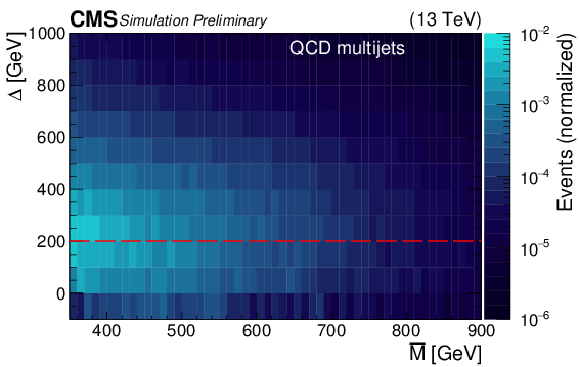
png pdf |
Figure 8-a:
Resolved search: The distribution of Δ as a function of ¯M, shown for simulated QCD multijet events (left) and a selected signal ˜t→qq′ with a m˜t= 500 GeV (right). All selection criteria are applied apart from that on the variable being presented, and the region above the red dashed line indicates the optimized region of selected Δ values. |

png pdf |
Figure 8-b:
Resolved search: The distribution of Δ as a function of ¯M, shown for simulated QCD multijet events (left) and a selected signal ˜t→qq′ with a m˜t= 500 GeV (right). All selection criteria are applied apart from that on the variable being presented, and the region above the red dashed line indicates the optimized region of selected Δ values. |
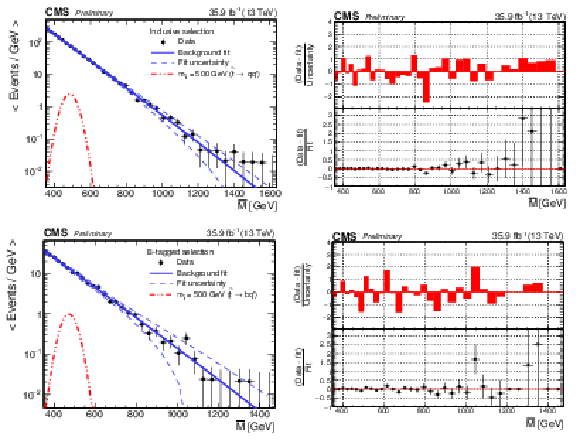
png pdf |
Figure 9:
Resolved search: Left: The ¯M distributions for the data (black points), along with the resulting fit of the functional form in Eq. (3) (blue line) for the inclusive selection (top) and b-tagged (bottom) selections. The expected signals from the ˜t→qq′ and ˜t→bq′ simulated samples at m˜t= 500 GeV are also presented (red lines) for the inclusive selection and b-tagged selections, respectively. Right: The bin-by-bin pull and residual distributions, as described in the text. |
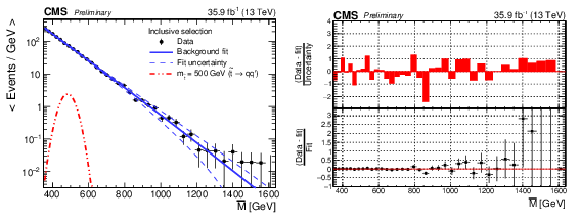
png pdf |
Figure 9-a:
Resolved search: Left: The ¯M distributions for the data (black points), along with the resulting fit of the functional form in Eq. (3) (blue line) for the inclusive selection (top) and b-tagged (bottom) selections. The expected signals from the ˜t→qq′ and ˜t→bq′ simulated samples at m˜t= 500 GeV are also presented (red lines) for the inclusive selection and b-tagged selections, respectively. Right: The bin-by-bin pull and residual distributions, as described in the text. |

png pdf |
Figure 9-b:
Resolved search: Left: The ¯M distributions for the data (black points), along with the resulting fit of the functional form in Eq. (3) (blue line) for the inclusive selection (top) and b-tagged (bottom) selections. The expected signals from the ˜t→qq′ and ˜t→bq′ simulated samples at m˜t= 500 GeV are also presented (red lines) for the inclusive selection and b-tagged selections, respectively. Right: The bin-by-bin pull and residual distributions, as described in the text. |

png pdf |
Figure 10:
Resolved search: Left: Gaussian fits on the mass of the simulated signals for various ˜t→qq′ masses probed in this search after applying the inclusive selection. Right: Signal efficiency as a function of m˜t for the inclusive and b-tagged selections. |
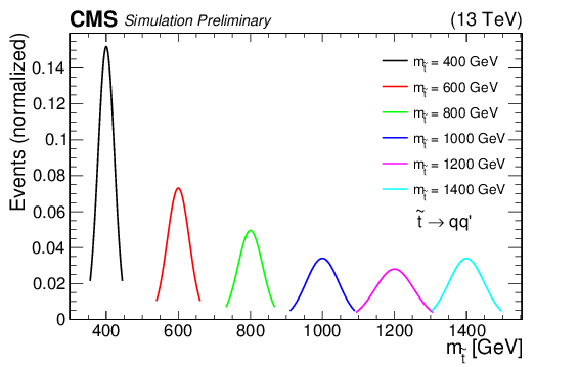
png pdf |
Figure 10-a:
Resolved search: Left: Gaussian fits on the mass of the simulated signals for various ˜t→qq′ masses probed in this search after applying the inclusive selection. Right: Signal efficiency as a function of m˜t for the inclusive and b-tagged selections. |
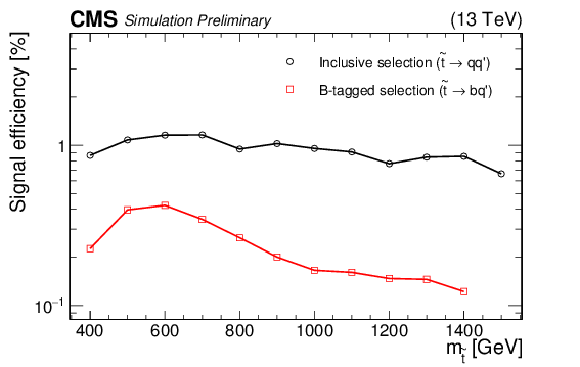
png pdf |
Figure 10-b:
Resolved search: Left: Gaussian fits on the mass of the simulated signals for various ˜t→qq′ masses probed in this search after applying the inclusive selection. Right: Signal efficiency as a function of m˜t for the inclusive and b-tagged selections. |

png pdf |
Figure 11:
Observed and expected 95% CL upper limits on the product of the cross section times the branching ratio (B2) as a function of m˜t. The branching ratio to quarks is assumed to be 100%. The boosted analysis probes 80 ≤m˜t< 400 GeV, while the resolved analysis searches for m˜t≥ 400 GeV. Left: limits using the inclusive selection for ˜t→qq′ assuming the RPV coupling λ′′312. Right: limits using the b-tagged selection for ˜t→bq′ assuming the RPV coupling λ′′323. The dashed pink line shows the NLO + NLL theoretical predictions for top squark pair production. |
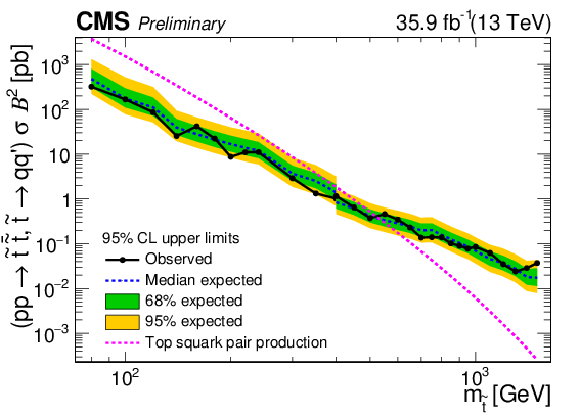
png pdf |
Figure 11-a:
Observed and expected 95% CL upper limits on the product of the cross section times the branching ratio (B2) as a function of m˜t. The branching ratio to quarks is assumed to be 100%. The boosted analysis probes 80 ≤m˜t< 400 GeV, while the resolved analysis searches for m˜t≥ 400 GeV. Left: limits using the inclusive selection for ˜t→qq′ assuming the RPV coupling λ′′312. Right: limits using the b-tagged selection for ˜t→bq′ assuming the RPV coupling λ′′323. The dashed pink line shows the NLO + NLL theoretical predictions for top squark pair production. |
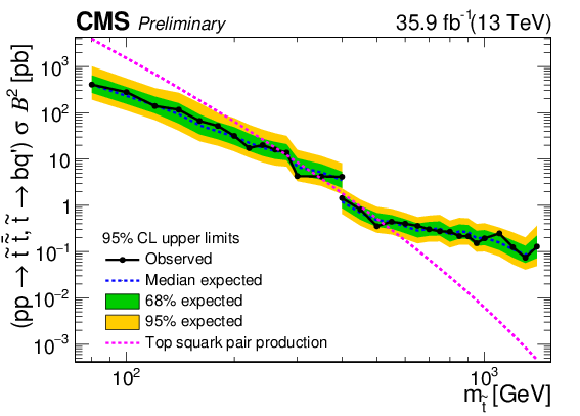
png pdf |
Figure 11-b:
Observed and expected 95% CL upper limits on the product of the cross section times the branching ratio (B2) as a function of m˜t. The branching ratio to quarks is assumed to be 100%. The boosted analysis probes 80 ≤m˜t< 400 GeV, while the resolved analysis searches for m˜t≥ 400 GeV. Left: limits using the inclusive selection for ˜t→qq′ assuming the RPV coupling λ′′312. Right: limits using the b-tagged selection for ˜t→bq′ assuming the RPV coupling λ′′323. The dashed pink line shows the NLO + NLL theoretical predictions for top squark pair production. |
| Tables | |

png pdf |
Table 1:
Signal selection criteria. |

png pdf |
Table 2:
Definition of the regions used in the QCD multijet background estimation for the boosted analysis. Region A is the signal dominated region while regions B, C, D are background dominated sideband regions. |
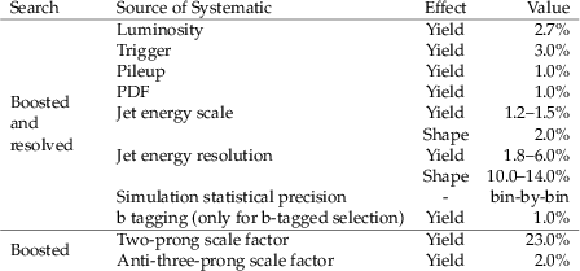
png pdf |
Table 3:
Summary of the systematic uncertainties on the signal acceptance. For the shape uncertainties, the value represents the percentage difference in the nominal value of the systematic uncertainty. |

png pdf |
Table 4:
Summary of the systematic uncertainties on the background prediction by source. |
| Summary |
| A search has been performed for the pair production of diquark resonances in two jet events in a boosted jet topology and in four-jet events in a resolved jet topology. Data is analyzed from proton-proton collisions at √s= 13 TeV collected in 2016 with the CMS detector corresponding to an integrated luminosity of 35.9 fb−1. In the boosted search the distribution of the average mass of the selected two jets has been investigated for localized disagreements between the data and the background estimate, consistent with a new resonance, while in the resolved analysis the average mass of the selected dijet pairs is examined for localized disagreements between data and the background expectations. The boosted search explores resonance masses between 60 and 450 GeV, while the resolved one covers masses above 350 GeV. We find agreement between observations and standard model expectations. These results are interpreted in the framework of RPV SUSY assuming the pair production of top squarks decaying to quarks via the λ′′312 or the λ′′323 couplings, assuming 100% branching ratios to ˜t→qq′ or ˜t→bq′, respectively. Upper limits are set at 95% confidence level on the pair production cross section of top squarks as a function of the top squark mass. We exclude top squark masses from 80 to 520 GeV assuming the λ′′312 coupling, and from 80 to 270 GeV, 285 to 340 GeV, and 400 to 525 GeV assuming the λ′′323 coupling. |
| References | ||||
| 1 | C. Kilic, T. Okui, and R. Sundrum | Colored resonances at the Tevatron: phenomenology and discovery potential in multijets | JHEP 07 (2008) 038 | 0802.2568 |
| 2 | C. T. Hill | Topcolor: top quark condensation in a gauge extension of the standard model | PLB 266 (1991) 419 | |
| 3 | G. D. Kribs, E. Poppitz, and N. Weiner | Flavor in supersymmetry with an extended R-symmetry | PRD 78 (2008) 055010 | 0712.2039 |
| 4 | J. A. Evans and Y. Kats | LHC coverage of RPV MSSM with light stops | JHEP 04 (2013) 028 | 1209.0764 |
| 5 | R. Barbier et al. | R-parity violating supersymmetry | PR 420 (2005) 1 | hep-ph/0406039 |
| 6 | ALEPH Collaboration | Search for supersymmetric particles with R parity violating decays in e+e− collisions at √s up to 209 GeV | EPJC 31 (2003) 1 | hep-ex/0210014 |
| 7 | CDF Collaboration | Search for pair production of strongly interacting particles decaying to pairs of jets in pˉp collisions at √s= 1.96 TeV | PRL 111 (2013) 031802 | 1303.2699 |
| 8 | CMS Collaboration | Search for pair-produced dijet resonances in four-jet final states in proton-proton collisions at √s= 7 TeV | PRL 110 (2013) 141802 | CMS-EXO-11-016 1302.0531 |
| 9 | CMS Collaboration | Search for pair-produced resonances decaying to jet pairs in proton-proton collisions at √s= 8 TeV | PLB 747 (2015) 98 | CMS-EXO-12-052 1412.7706 |
| 10 | ATLAS Collaboration | Search for pair-produced massive coloured scalars in four-jet final states with the ATLAS detector in proton-proton collisions at √s= 7 TeV | EPJC 73 (2013) 2263 | 1210.4826 |
| 11 | ATLAS Collaboration | A search for top squarks with R-parity-violating decays to all-hadronic final states with the ATLAS detector in √s= 8 TeV proton-proton collisions | JHEP 06 (2016) 067 | 1601.07453 |
| 12 | ATLAS Collaboration | A search for pair-produced resonances in four-jet final states at √s= 13 TeV with the ATLAS detector | EPJC 78 (2018) 250 | 1710.07171 |
| 13 | CMS Collaboration | The CMS experiment at the CERN LHC | JINST 3 (2008) S08004 | CMS-00-001 |
| 14 | CMS Collaboration | CMS luminosity measurements for the 2016 data taking period | CMS-PAS-LUM-17-001 | CMS-PAS-LUM-17-001 |
| 15 | CMS Collaboration | The CMS trigger system | JINST 12 (2017) P01020 | CMS-TRG-12-001 1609.02366 |
| 16 | J. Alwall et al. | The automated computation of tree-level and next-to-leading order differential cross sections, and their matching to parton shower simulations | JHEP 07 (2014) 079 | 1405.0301 |
| 17 | T. Sjostrand et al. | An Introduction to PYTHIA 8.2 | CPC 191 (2015) 159 | 1410.3012 |
| 18 | CMS Collaboration | Event generator tunes obtained from underlying event and multiparton scattering measurements | EPJC 76 (2016) 155 | CMS-GEN-14-001 1512.00815 |
| 19 | S. Alioli, S.-O. Moch, and P. Uwer | Hadronic top-quark pair-production with one jet and parton showering | JHEP 01 (2012) 137 | 1110.5251 |
| 20 | T. Melia, P. Nason, R. Rontsch, and G. Zanderighi | W+W+ plus dijet production in the POWHEGBOX | EPJC 71 (2011) 1670 | 1102.4846 |
| 21 | S. Kallweit et al. | NLO QCD+EW predictions for V+jets including off-shell vector-boson decays and multijet merging | JHEP 04 (2016) 021 | 1511.08692 |
| 22 | S. Kallweit et al. | NLO QCD+EW automation and precise predictions for V+multijet production | in Proceedings, 50th Rencontres de Moriond, QCD and high energy interactions: La Thuile, Italy, March 21-28, 2015, p. 121 2015 | 1505.05704 |
| 23 | J. M. Lindert et al. | Precise predictions for V+jets dark matter backgrounds | EPJC 77 (2017) 829 | 1705.04664 |
| 24 | CMS Collaboration | Search for dark matter produced with an energetic jet or a hadronically decaying W or Z boson at √s= 13 TeV | JHEP 07 (2017) 014 | CMS-EXO-16-037 1703.01651 |
| 25 | S. Kallweit et al. | NLO electroweak automation and precise predictions for W+multijet production at the LHC | JHEP 04 (2015) 012 | 1412.5157 |
| 26 | GEANT4 Collaboration | Geant4 --- a simulation toolkit | NIMA 506 (2003) 250 | |
| 27 | CMS Collaboration | Particle-flow reconstruction and global event description with the CMS detector | JINST 12 (2017) P10003 | CMS-PRF-14-001 1706.04965 |
| 28 | M. Cacciari, G. P. Salam, and G. Soyez | The anti-kt jet clustering algorithm | JHEP 04 (2008) 063 | 0802.1189 |
| 29 | M. Cacciari, G. P. Salam, and G. Soyez | FastJet user manual | EPJC 72 (2012) 1896 | 1111.6097 |
| 30 | M. Cacciari and G. P. Salam | Pileup subtraction using jet areas | PLB 659 (2008) 119 | 0707.1378 |
| 31 | CMS Collaboration | Jet energy scale and resolution in the CMS experiment in pp collisions at 8 TeV | JINST 12 (2017) P02014 | CMS-JME-13-004 1607.03663 |
| 32 | CMS Collaboration | Determination of jet energy calibration and transverse momentum resolution in CMS | JINST 6 (2011) P11002 | CMS-JME-10-011 1107.4277 |
| 33 | D. Krohn, J. Thaler, and L.-T. Wang | Jet trimming | JHEP 02 (2010) 084 | 0912.1342 |
| 34 | S. D. Ellis, C. K. Vermilion, and J. R. Walsh | Recombination algorithms and jet substructure: pruning as a tool for heavy particle searches | PRD 81 (2010) 094023 | 0912.0033 |
| 35 | J. Thaler and K. Van Tilburg | Maximizing boosted top identification by minimizing N-subjettiness | JHEP 02 (2012) 093 | 1108.2701 |
| 36 | CMS Collaboration | Identification of heavy-flavour jets with the CMS detector in pp collisions at 13 TeV | JINST 13 (2018) P05011 | CMS-BTV-16-002 1712.07158 |
| 37 | C. Borschensky et al. | Squark and gluino production cross sections in pp collisions at √s= 13 , 14, 33 and 100 TeV | EPJC 74 (2014) 3174 | 1407.5066 |
| 38 | W. Beenakker et al. | NLO+NLL squark and gluino production cross-sections with threshold-improved parton distributions | EPJC 76 (2016) 53 | 1510.00375 |
| 39 | J. Rojo | PDF4LHC recommendations for Run II | in Proceedings, 24th International Workshop on Deep-Inelastic Scattering and Related Subjects (DIS 2016): Hamburg, Germany, April 11-15, 2016, volume DIS2016, p. 018 2016 | 1606.08243 |
| 40 | CMS Collaboration | Search for massive resonances decaying into WW, WZ, ZZ, qW, and qZ with dijet final states at √s= 13 TeV | PRD 97 (2018) 072006 | CMS-B2G-17-001 1708.05379 |
| 41 | CMS Collaboration | Identification techniques for highly boosted W bosons that decay into hadrons | JHEP 12 (2014) 017 | CMS-JME-13-006 1410.4227 |
| 42 | CMS Collaboration | Jet algorithms performance in 13 TeV data | CMS-PAS-JME-16-003 | CMS-PAS-JME-16-003 |
| 43 | CDF Collaboration | First search for multijet resonances in √s= 1.96 TeVpˉp collisions | PRL 107 (2011) 042001 | 1105.2815 |
| 44 | CMS Collaboration | Search for three-jet resonances in pp collisions at √s= 7 TeV | PRL 107 (2011) 101801 | CMS-EXO-11-001 1107.3084 |
| 45 | CMS Collaboration | Search for three-jet resonances in pp collisions at √s= 7 TeV | PLB 718 (2012) 329 | CMS-EXO-11-060 1208.2931 |
| 46 | CMS Collaboration | Searches for light- and heavy-flavour three-jet resonances in pp collisions at √s= 8 TeV | PLB 730 (2014) 193 | CMS-EXO-12-049 1311.1799 |
| 47 | CMS Collaboration | Search for narrow resonances decaying to dijets in proton-proton collisions at √s= 13 TeV | PRL 116 (2016) 071801 | CMS-EXO-15-001 1512.01224 |
| 48 | A. L. Read | Presentation of search results: the CL(s) technique | JPG 28 (2002) 2693 | |
| 49 | T. Junk | Confidence level computation for combining searches with small statistics | NIMA 434 (1999) 435 | hep-ex/9902006 |
| 50 | G. Cowan, K. Cranmer, E. Gross, and O. Vitells | Asymptotic formulae for likelihood-based tests of new physics | EPJC 71 (2011) 1554 | 1007.1727 |

|
Compact Muon Solenoid LHC, CERN |

|

|

|

|

|

|